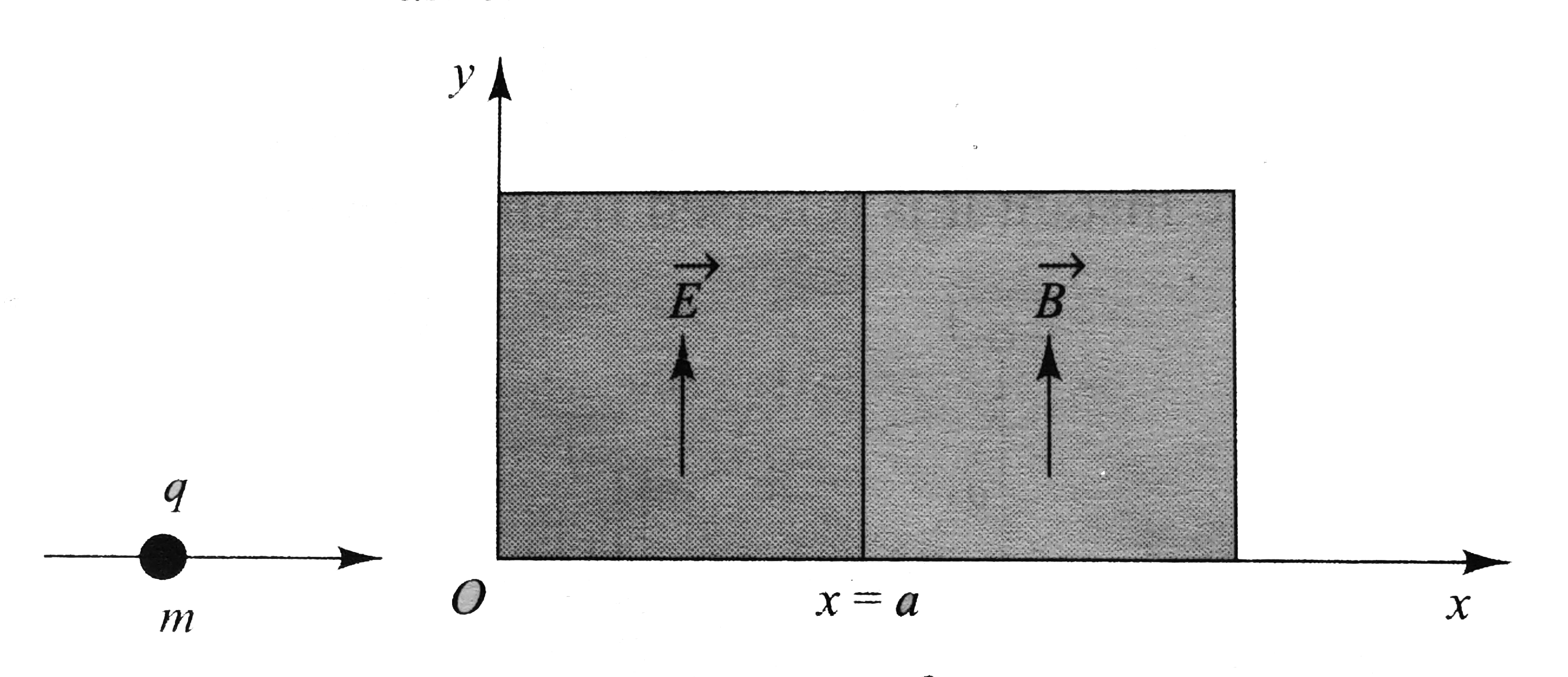For a positively charged particle moving in a x−y plane initially along the x−aξs , there is a sudden change in its path due to the presence of electric and//or magnetic fields beyond p . The curved path is shown in the x−yplane and is found to be non - circular. Which one of the following combinations is possible ?

E=0,B=bˆj+cˆk
E=aˆ,B=cˆk+aˆi
E=0,B=cˆj+bˆk
E=aˆi,B=cˆk+bˆj
The correct Answer is:B
Electric field can deviate the path of the particle in the shown direction only when it is along negative y-direction. In the given options E is either zero or along x-direction. Hence, it is the magnetic field which is really responsible for its curved path. Options (A) and (C) cannot be accepted as the path will be circular in that case. Option (D) is wrong because in that case component of net force on the particle also comes in direction which is not acceptable as the particle is moving in x-y plane. Only in option (B) the particle can move in x-y plane. In option (D) Fnet=qE+q(v+B) initial is along x-direction. So let v=vˆi
∴Fnet=qaˆi+q[(vˆi)×(cˆk+bj)]=qaˆi−qvcˆj+qvbˆk. In the onption b Fnet=q(ai)+q[(vˆi)×(ˆk+aˆi)]=qaˆi+qvcˆj
Topper's Solved these Questions
- MAGNETIC EFFECTS OF CURRENT BOOK - VMC MODULES ENGLISHCHAPTER - MAGNETIC EFFECTS OF CURRENT EXERCISE - JEE Main (Archive)
75 Videos
- LIQUIDSBOOK - VMC MODULES ENGLISHCHAPTER - LIQUIDSEXERCISE - JEE ADVANCED (LEVEL -2)
55 Videos
- MOCK TEST 1BOOK - VMC MODULES ENGLISHCHAPTER - MOCK TEST 1EXERCISE - PART I : PHYSICS (SECTION-2)
10 Videos
Similar Questions
Position vector of a particle moving in x−y plane at time t is r=a(1−cosωt)ˆi+asinωtˆj. The path of the particle is
View SolutionA positively charged particle moving along x-axis with a certain velocity enters a uniform electric field directed along positive y-axis. Its
View Solutionx and y co-ordinates of a particle moving in x−y plane at some instant of time are x=2t and y=4t.Here x and y are in metre and t in second. Then
The path of the particle is a…….
View SolutionA charged particle moves along a circle under the action of possible constant electric and magnetic fields. Which of the following are possible?
View SolutionA particle of mass m and positive charge q is projected with a speed of v0 in y–direction in the presence of electric and magnetic field are in x–direction. Find the instant of time at which the speed of particle becomes double the initial speed.
View SolutionA point mass is moving in the x-y plane. Its acceleration is a constant vector perpendicular to the x-axis. Which of the following do/does not charge with time ?
View SolutionA particle of mass m carrying a positive charge q moves simple harmonically along the x-axis under the action of a varying electric field E directed along the x-axis. The motion of the particle is confined between x=0 and x=2l. The angular frequency of the motion is ω. Then which of the following is correct ?
View SolutionA positively charged particle, having charge q, is accelerated by a potential difference V. This particle moving along the x-axis enters a region where an electric field E exists. The direction of the electric field is along positive y-axis. The electric field exists in the region bounded by the lines x=0andx=a. Beyond the line x=a (i.e., in the region x>a), there exists a magnetic field of strength B, directed along the positive y-axis. Find

a. at which point does the particle meet the line x=a.
b. the pitch of the helix formed after the particle enters the region x≥a. (Mass of the particle is m.)
View SolutionAn electric dipole is placed at origin in the xy plane with its orientation along the positive x-axis. The direction is electric field .
View SolutionA positively charged particle of mass m and charge q is projected on a rough horizontal x-y plane surface with z-axis in the vertically upward direction. Both electric and magnetic fields are acting in the region and given by →E=−E0ˆkand→B=−B0ˆk , respectively. The particle enters into the field at (a0,0,0) with velocity →v=v0ˆj. The particle starts moving in some curved path on the plane. If the coefficient of friction between the particle and the plane is μ. Then calculate the
(a) time when the particle will come to rest
(b) distance travelled by the particle when it comes to rest.

View Solution
